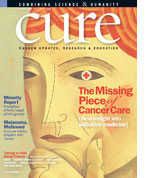Doctors in Training
Physicians and medical students are now being trained in palliative medicine.
When Kelly Letsinger, MD, attended medical school in Louisiana, she was always getting in trouble for climbing in bed with her patients. “I didn’t actually get in the bed,” she explains. “I just sort of sat down and scooted next to them.” When the time came to choose a specialty, she realized she needed a field that would be very hands-on.
As an intern, she treated a seriously ill elderly woman. She inserted the central lines, got the machines in place, and was proud and relieved when the patient survived the night. But the next morning, the horrified family told the young doctor, “She would never have wanted to be like this.” Dr. Letsinger had made correct technical decisions, performed the correct procedures. “But I never thought about the big picture, the whole patient,” recalls Dr. Letsinger.
The experience stuck with her, and after her internal medicine residency at Virginia Commonwealth University, she signed up for an additional fellowship at the Thomas Palliative Care Unit of VCU’s Massey Cancer Center.
Tom Smith, MD, who runs the unit, is an oncologist who in the 1980s set out to learn more about managing symptoms and family dynamics. He became a leader in the field now known as palliative medicine, and a mentor to many doctors and nurses—both those in palliative care and those reshaping oncology to include training in breaking bad news, goal setting, and pain control.
Dr. Letsinger’s timing was fortuitous. While she was training in 2006, the American Board of Medical Specialties officially recognized palliative medicine as a subspecialty—an acknowledgment doctors say will give the field more exposure among medical students. Dr. Letsinger, now a palliative care physician treating cancer and other patients at Akron City Hospital, will be among the first young doctors to take the boards this year.
Official recognition gave a boost to the specialty, but there are still regulatory and institutional barriers. The medical system generally pays doctors who perform procedures—chemotherapy, surgery, and the like—a lot more than they pay doctors who spend hours coordinating care or running “family meetings.”
Financing the training is a challenge. Some hospices are training young physicians, but they can’t tap into federal funds for graduate medical education, according to Cameron Muir, MD, past president of the American Academy of Hospice and Palliative Medicine, who treats cancer patients through Capital Hospice’s palliative care partnerships near Washington, D.C. And with the number of training slots fixed under federal formulas, hospitals are reluctant to expand palliative care fellowships if it means cutting something more lucrative, like cardiology, says Diane Meier, MD, director of the Center to Advance Palliative Care in New York.
Still, even without federal changes, palliative care is growing. Patients are demanding it, and physicians like Dr. Letsinger have their hands outstretched to supply it.
